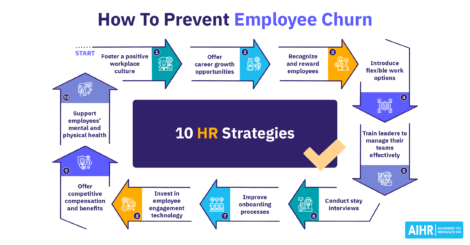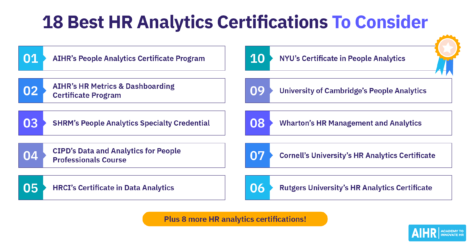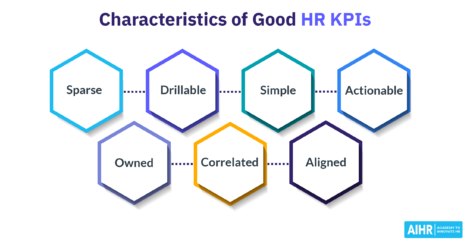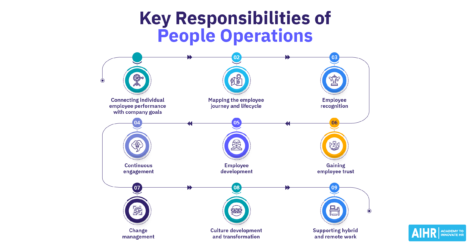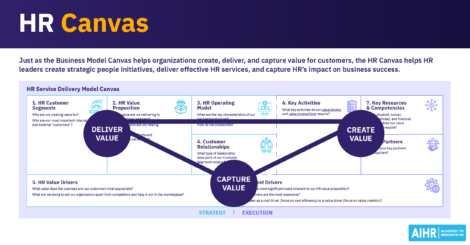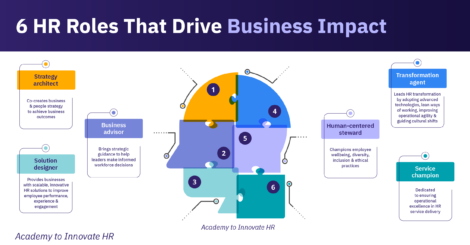What Is the Role of the HR Analyst? A Full Guide
According to tech industry veteran Peter Sondergaard, “Information is the oil of the 21st century, and analytics is the combustion engine.” In HR, HR Analysts fuel smarter decision-making by transforming workforce data into insights that drive talent strategy, engagement, and efficiency.

The HR analyst plays a crucial role in collecting, structuring, analyzing, and reporting on HR processes and data. In this article, we will discuss the key competencies for an HR Analyst’s job, how to become one, career paths, and salary levels.
Contents
What does an HR Analyst do?
HR Analyst skills
How to become an HR Analyst
HR Analyst vs HR Business Partner
HR Analyst vs. HR Generalist
HR Analyst salary
HR Analyst career path
HR Analyst example job postings
FAQ
What does an HR Analyst do?
An HR Analyst, also referred to as HR Data Analyst or People Analyst, plays a key role in helping organizations make data-driven decisions related to their workforce. They analyze HR data, identify trends, and provide insights that improve processes like recruitment, retention, and employee engagement. The HR Analyst job growth rate is estimated to be 11%, highlighting the demand for these types of roles in the market.
Key responsibilities of the HR Analyst include:
- Collect and analyze HR data: Evaluate metrics like turnover rates, employee satisfaction, and absenteeism.
- Generate reports and dashboards: Present insights to HR teams and leadership to inform decision-making.
- Monitor workforce trends: Identify patterns in hiring, productivity, or retention to recommend improvements.
- Support compliance efforts: Ensure HR practices align with employment laws and company policies.
- Collaborate on strategy: Work with HR and management teams to develop strategies for workforce planning.
- Evaluate HR tools and systems: Assess the performance of HR software and suggest optimizations.
- Conduct salary benchmarking: Research market data to ensure competitive and fair compensation practices.
Note that the HR Analyst has a broad role and – depending on the organization – will be asked to focus on different tasks.
HR Analyst skills
The exact skills an HR Analyst should have will, again, depend on the organization. Quite a few organizations are looking for an HR Analyst with predominantly soft and HR skills. This makes the analyst’s function profile very similar to an HR Business Partner. Other organizations are really looking for a data analyst role. When applying for a job, read the job posting thoroughly to understand what type of role it is.
Here are some common skills that an HR Analyst should have.
1. Business acumen
Business acumen is becoming increasingly important for HR roles. The same holds true for the HR Analyst.
Before you analyze data, you need to know what project you will work on and how the data analysis will impact the business. Business acumen is an essential skill for any analyst who is involved in either simple data analysis or in an end-to-end analytics project.
2. Communication & consultation
Whether you’re spending most of your time analyzing data or only very little, you need to talk to the business, manage stakeholders and their expectations, and communicate the results of an analytics project to the relevant audiences. Hence, communication and consultation are essential for HR Analysts.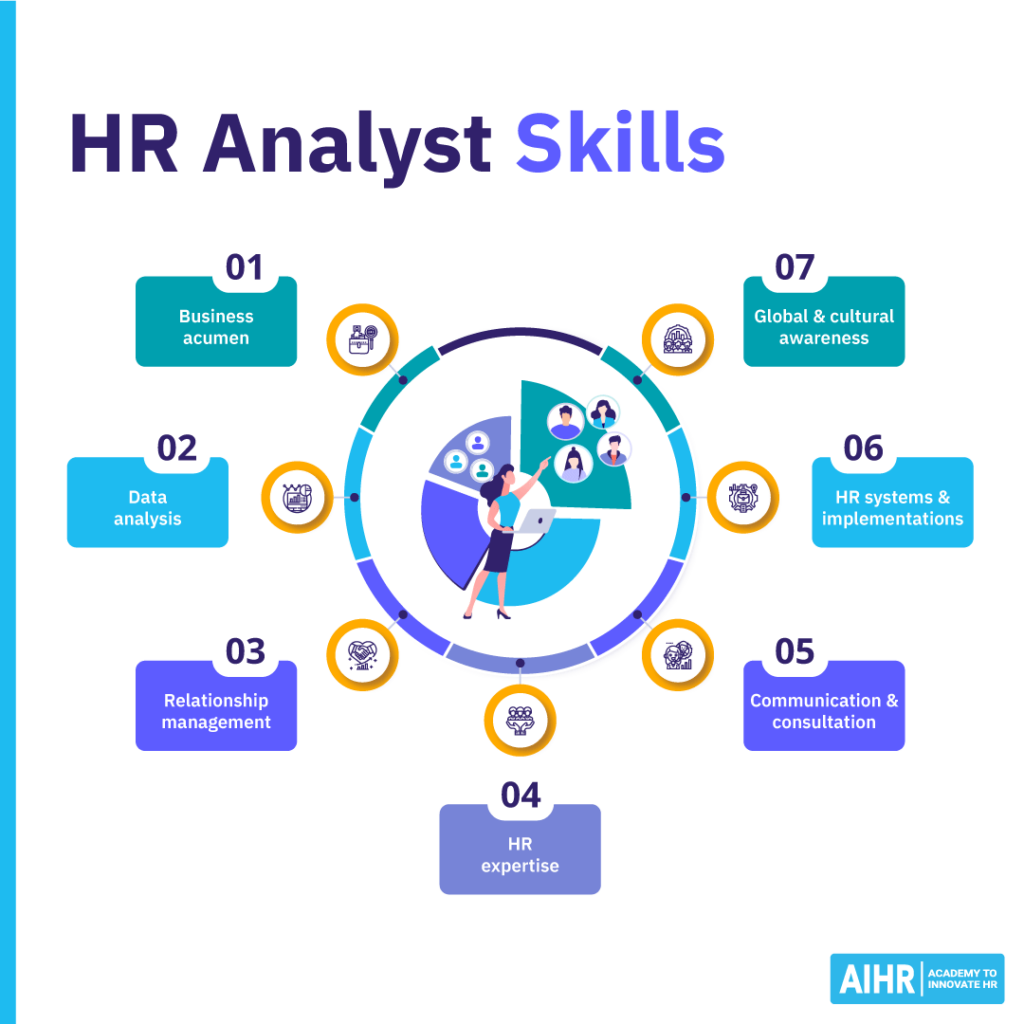
3. Relationship management
As an HR Analyst, it is key to effectively manage relationships and stakeholders. Expectation management is a requirement for analytics success. In addition, you need to keep the business involved in your analytics project and keep them up to date on progress and potential setbacks.
4. HR expertise
Whether you’re more on the business partner side of the analyst role or crunching numbers every single day, HR expertise is an essential skill. This expertise touches almost everything you do in your job.
HR expertise can be divided into three key areas:
- Knowledge of the science behind what we do in HR
- Knowledge of HR best practices
- Understanding of the key HR processes.
5. Data analysis
The HR data analyst is involved in the basics of data-driven HR in the organization. For most organizations, this entails (ad hoc) reporting and dashboarding.
In order to accurately report on HR data, the analyst is involved in the aggregation of data, maintaining HR data quality, and the analysis of data.
Depending on the data maturity of the organization, these reports can be ad hoc. Ad hoc reporting means that the information has to be manually retrieved from the systems for reporting and analysis. This kind of data often needs to be cleansed as well – which may take a lot of time.
More mature organizations have automated this process. This makes reporting less time-consuming, and the analyst can focus on analyses that add more value than basic reporting, like predictive analyses.
Competencies required for this include strong attention to detail and a strong drive to use data to answer business questions.
6. HR systems & implementation
HR data comes from HR systems, often referred to as the Human Resources Information System (HRIS). These transactional systems contain most of the data that the HR Analyst works with.
Implementing, maintaining, and updating these systems is part of the HR Analyst’s responsibility.
7. Global and cultural awareness
HR data often spans multiple regions, especially in large international organizations, making global and cultural awareness a key skill. As an analyst, you’ll work with data from diverse locations, requiring an understanding of how cultural differences influence HR practices, employee behaviors, and data collection methods. This awareness helps you interpret data accurately and provide insights that are relevant across different cultural contexts.
How to become an HR Analyst
Breaking into HR analytics or people analytics requires a mix of HR knowledge, data skills, and familiarity with HR technology. Whether you’re coming from an HR background or a more technical field, the right approach can help you bridge the gaps and stand out to employers. Here are some key steps to build the skills and experience needed for an HR analyst role:
Understand the job requirements
As we’ve already mentioned, job requirements will differ per role and organization. Check job openings for HR analyst roles in your desired location or field to identify common skills and tools required.
The standard requirement for an HR analyst position is domain experience in HR. HRM studies or a background in industrial and organizational psychology are usually considered highly relevant.
A background in economics, statistics, or analytics is also beneficial. People with these kinds of backgrounds bring a unique set of quantitative skills that most people with an HRM background are missing. This background often requires complementary training in Human Resources.
Get hands-on with HR systems
Many HR jobs require HRIS experience, so learning to work with systems like Workday, SAP SuccessFactors, or Oracle HCM is key for an HR Analyst job.
Some of the things you can do include:
- Take online courses on digital HR and analytics
- Explore interfaces and reporting features of HRIS providers offer demo accounts or trial versions
- If you’re already working in HR, check out the HR reports, dashboards, or data extraction in your company’s HRIS.
Develop visualization & reporting skills
HR Analysts frequently use tools like Tableau, Power BI, or Qlik to create HR dashboards and reports. A must-have skill is proficiency in Microsoft Excel. This is still used in most organizations and an understanding of how to combine worksheets and analyze large amounts of data using pivot tables are usually considered elementary.
You also need to build a foundational understanding of key HR metrics like turnover rates, employee engagement, and recruitment efficiency.
Gain practical experience
Real-life experience is one of the best ways to build confidence and strengthen your resume. If you’re transitioning into HR analytics, look for opportunities to work with HR data in your current role or take on projects that showcase your skills.
Some ways to gain experience:
- Volunteer for HR reporting tasks if you’re already in an HR-related role
- Work on personal projects—analyze publicly available HR datasets to practice data visualization and reporting
- Apply for internships or entry-level roles in HR analytics to get exposure to real-world HR data
- Freelance or contribute to HR analytics projects on platforms like Kaggle or GitHub.
Prepare for job interviews
When applying for jobs, it’s helpful to review common HR analyst interview questions to understand what employers look for.
Practice explaining HR metrics, data analysis techniques, and how you’ve used HR tools in past experiences to address the interviewees’ queries. Be ready to discuss real-world scenarios, such as how you would analyze turnover data or improve HR reporting.
Stay updated on HR analytics trends
HR technology and analytics are evolving quickly, so staying informed can give you a competitive edge. You can start by following HR analytics thought leaders and pages on LinkedIn and industry blogs.
Other great ways of keeping up to date with the developments in the field include attending webinars and conferences on HR technology and workforce analytics and joining HR analytics communities and forums to learn from professionals in the field.
HR Analyst vs HR Business Partner
We already hinted a few times about the similarities between the HR analyst and the HR business partner’s job. Both roles contribute to HR strategy but focus on different areas.
An HR Analyst specializes in collecting, analyzing, and reporting data, using technical skills to provide insights. In contrast, an HR Business Partner (HRBP) works closely with managers, using soft skills to solve HR-related challenges and align people strategies with business goals.
The HR BP acts as an internal consultant, advising on operational and strategic HR matters. When data-driven solutions are needed, the analyst steps in to define problems and provide insights.
As HRBPs gain analytics skills, the line between these roles can blur, leading some companies to use the term “HR Analyst” when they really mean “HR Business Partner.”
HR Analyst vs. HR Generalist
While both roles contribute to HR operations, they have distinct focuses.
An HR Analyst works with HR data, reporting, and workforce analytics, using tools like Excel, Power BI, and HRIS to identify trends and improve decision-making. Their role is more technical and data-driven.
An HR Generalist, on the other hand, handles a broad range of HR functions, including recruitment, employee relations, compliance, and benefits administration. They are involved in day-to-day HR operations and often serve as the first point of contact for employees.
While HR Analysts focus on data and insights, generalists work more directly with employees and HR policies. Some companies may blend these roles, but in larger organizations, they are typically separate functions.
HR Analyst salary
Salaries for the HR analyst role can vary wildly depending on the size of the company, the location, and the experience of the analyst. In the United States, you can expect to earn between $67,000-$110,000 in the midwestern United States, while someone doing the same job in New York City could expect to earn between $69,000 and $117,000 per year.
Payscale.com puts the average base salary at around $65,000.
HR Analyst career path
It is hard to map a well-defined career path in today’s world. Usually, you start as a junior analyst and can grow your way to a senior analyst position.
The data-driven mindset of an analyst is increasingly popular and looked for in management positions.
Career paths to becoming HR Manager and HR Director are available, as well as horizontal paths towards (senior) Human Resources Generalist, or the more specialized Human Resources Information System Analyst and HRIS manager.
HR Analyst example job postings
Because defining what an HR Analyst exactly differs from business to business, we’ve looked at job postings from companies that hire HR Analysts to see the commonalities and dissimilarities in responsibilities and requirements.
A brief job analysis
We conducted a brief analysis of HR Analyst job postings to help you understand the role of the HR Analyst even better. Here are a few interesting details:
- Many job postings explicitly mention advanced Excel skills, including PivotTables, VLOOKUP, and data manipulation.
- Some job postings emphasize data visualization tools like Power BI, but none require deep statistical expertise in SPSS, STATA, R, or Python.
- Many roles require familiarity with Workday, SAP SuccessFactors, or other HR systems.
- A lot of companies seem to be looking for candidates with Excel expertise and an interest in HR rather than HR professionals with a strong data background, making these positions accessible for early-career professionals.
- A significant portion of job postings emphasize administrative HR tasks, such as updating HR data, preparing reports, and supporting employee engagement initiatives.
A final word
To sum up, if you’re looking to start a career as an HR analyst, focus on building strong Excel skills and gaining familiarity with HR systems like Workday or SAP SuccessFactors. Entry-level HR roles that involve reporting, data management, or HR operations can be a great stepping stone, as many companies prioritize candidates with hands-on experience in these areas. Taking courses in HR analytics or data visualization tools like Power BI can also help you stand out.
FAQ
The HR analyst plays a key role in collecting, structuring, analyzing, and reporting on HR processes and data. Essential competencies include data analysis, business acumen, relationship management, HR expertise, communication, HR systems, and cultural awareness.
Salaries for the HR analyst role can vary wildly depending on the size of the company, the location, and the experience of the analyst. In the United States, you can expect to earn between $67,000-$117,000.
There is no set way to become an HR analyst. Many professionals come from backgrounds in psychology, business administration, HR management, or data analytics. Strong Excel skills are a must, as data analysis plays a central role in the job. While experience with R or Python is often optional, having these skills can give you a competitive edge. Gaining hands-on experience with HR systems (e.g., Workday, SAP SuccessFactors) and data visualization tools (e.g., Power BI, Tableau) can also help you stand out.
Learn more
Related articles
Are you ready for the future of HR?
Learn modern and relevant HR skills, online







